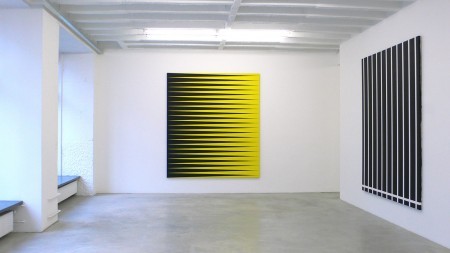Ann Edholm
07 Mar - 25 Apr 2009
Presented in Berlin for the first time, Ann Edholm’s work has perhaps never been as close to her own autobiographical narrative as in these paintings. Working in extended series Edholm stages large, occasionally even monumental paintings verging on both geometric abstraction and subtle expressionism. The latter reveals itself in barely perceptible details such as small thumbprints and smear marks made by the brush or, more often, by the palette knife, thus destabilizing the seemingly solid compositional patterns of basic geometric shapes. With an elaborate network of cultural, religious and symbolic references, Edholm meticulously merges classical painting with elemental geometric shapes together with sudden painterly gestures. While at the first glance these marks may appear as smudges, they reveal unexpected connotations to other traditions of Western art as well as to highly contemporary discourses concerning the relationship between painting and the self.
Included in the series ‘Tongue on the Tip’, originally to be comprised of 14 large paintings and now a series of 22, is a final painting on the mystery of the resurrection according to the ancient legend of the Fourteen Stations of the Cross along the Via Dolorosa, a theme represented by, among others, Barnett Newman. The latter is an artist especially close to Ann Edholm besides painters like Ellsworth Kelly, Kazimir Malevich, Matthias Grünewald and Arnold Böcklin. However, the current paintings are perhaps more autobiographically motivated than any of the earlier works in the series. Though part of a still growing narrative beginning at the end of the ‘90s, the paintings here are all-embracingly entitled ‘Hinter dem Schweigen/At the Back of Silence’. According to the artist herself, whose mother was born in Berlin and lived through the bombings of the German capital at the end of World War II, the paintings are conditioned by such a silenced experience that any violence is muted, a silence celebrated by a lamenting Kaddish so deep that you hear only the joy of those embracing life, those ever repeated incantations of rejoicing. Thus, it is no coincidence that some of the paintings are titled ‘Zungensprache/Glossolalia’, and that some of the smaller paintings on aluminium are pierced by nails painfully stuck into the flesh of paint.
“The body sees the image”, Edholm says. In fact, the paintings’ monumentality and physicality evoke exactly that: the position of the viewer in relation to his or her own physical participation in a process involving both his or her own body and the painting itself as a body in space. In Edholm’s vision, the image opens up the painting into a space of both conceptual thoughts and physical experiences. The image is transformed into a window looking in on the space of the beholder. No, it is not a matter of Renaissance central perspective in which the vanishing point is “behind” the windowpane. On the contrary, the vanishing point seems to emerge on the same side of the pane as the viewer: someone is looking at you while, at the same time, the painting still obstinately asserts its own definition as a pure object. The image opens the space at the back of silence. Edholm's works are deliberately construed to minimise interpretative effort and pave the way for a deeper, individual, and spiritually founded encounter with the visual, whether this encounter hurts or brings painterly joyfulness into the realm of enjoying art.
Professor, Ph.D Tom Sandqvist
Included in the series ‘Tongue on the Tip’, originally to be comprised of 14 large paintings and now a series of 22, is a final painting on the mystery of the resurrection according to the ancient legend of the Fourteen Stations of the Cross along the Via Dolorosa, a theme represented by, among others, Barnett Newman. The latter is an artist especially close to Ann Edholm besides painters like Ellsworth Kelly, Kazimir Malevich, Matthias Grünewald and Arnold Böcklin. However, the current paintings are perhaps more autobiographically motivated than any of the earlier works in the series. Though part of a still growing narrative beginning at the end of the ‘90s, the paintings here are all-embracingly entitled ‘Hinter dem Schweigen/At the Back of Silence’. According to the artist herself, whose mother was born in Berlin and lived through the bombings of the German capital at the end of World War II, the paintings are conditioned by such a silenced experience that any violence is muted, a silence celebrated by a lamenting Kaddish so deep that you hear only the joy of those embracing life, those ever repeated incantations of rejoicing. Thus, it is no coincidence that some of the paintings are titled ‘Zungensprache/Glossolalia’, and that some of the smaller paintings on aluminium are pierced by nails painfully stuck into the flesh of paint.
“The body sees the image”, Edholm says. In fact, the paintings’ monumentality and physicality evoke exactly that: the position of the viewer in relation to his or her own physical participation in a process involving both his or her own body and the painting itself as a body in space. In Edholm’s vision, the image opens up the painting into a space of both conceptual thoughts and physical experiences. The image is transformed into a window looking in on the space of the beholder. No, it is not a matter of Renaissance central perspective in which the vanishing point is “behind” the windowpane. On the contrary, the vanishing point seems to emerge on the same side of the pane as the viewer: someone is looking at you while, at the same time, the painting still obstinately asserts its own definition as a pure object. The image opens the space at the back of silence. Edholm's works are deliberately construed to minimise interpretative effort and pave the way for a deeper, individual, and spiritually founded encounter with the visual, whether this encounter hurts or brings painterly joyfulness into the realm of enjoying art.
Professor, Ph.D Tom Sandqvist

